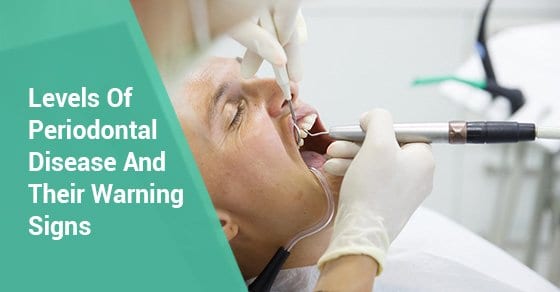Periodontal disease refers to an advanced form of gum disease that causes the gums to pull away from the teeth, creating spaces referred to as ‘pockets’ that become filled with harmful bacteria. The body’s immune system attempts to fight off the resulting infection as the plaque spreads below the gum line.

These activities cause the bone and connective tissue holding teeth in place to break down, and if not treated, the teeth become loose and eventually come off. At this point, you may also suffer from other dental problems and systemic issues, including:
- Progressing bone loss
- Shifting teeth
- Extensive bleeding and pus
- Gum recession and sensitivity
Fortunately, periodontal disease is an ongoing infection that develops through four stages, each with its own set of symptoms that if detected, can lead to early treatment.
Level 1: Gingivitis
This is the first stage of gum disease with very few signs that are barely noticeable. Some indications of gingivitis include:
- Redness and swelling of the gums
- Occasional bad breath
- Bleeding when flossing
- Probing depths of 2 to 4 mm
At this point, bone loss has not yet started, and the bacterial infection is completely reversible with good at-home oral hygiene, which includes brushing and flossing, as well as regular dental check ups with professional cleaning.
Level 2: Slight Periodontal Disease / Level 3: Moderate Periodontal Disease
With gingivitis, the infectious bacteria (plaque) get into the spaces between your teeth and start infecting the gums. If not treated, the infection begins to extend deeper under the gums where it can damage the supporting bone, resulting in deeper pockets that lead to bone loss.
At this stage, periodontal disease is still silent and painless with few signs, including:
- Increased gum redness
- More bleeding on brushing and flossing
- Worsening bad breath
- Probing depths extend to 4 to 5 mm and then 6 to 7 mm
At this stage, the bacteria cannot be eliminated through daily oral hygiene. You should visit your dentist for scaling and root planing to remove deep bacteria (plaque and tartar) deposits causing the infection.
Level 4: Advanced Periodontal disease
The infection further deepens and the symptoms are no longer silent or painless. Fifty to 90 per cent bone loss can occur, increasing the risk of tooth loss.
Patients with Advanced Periodontal Disease should see a Periodontist.
Signs include:
- Swelling, redness, and oozing gums
- Receding gums
- Cold sensitivity
- Severe bad breath
- Tooth mobility worsens
- Pain when chewing
- Mouth sores that won’t go away
- Consistent bad taste in the mouth
- Pus between the teeth and gum line
- Spaces between teeth that affect how your teeth meet when biting down
- Pockets with a depth of over 7 mm
Since the early signs of periodontal disease are not very noticeable, you should keep your dental checkups every four to six months, so your dentist can detect any problems early and recommend the appropriate treatment.